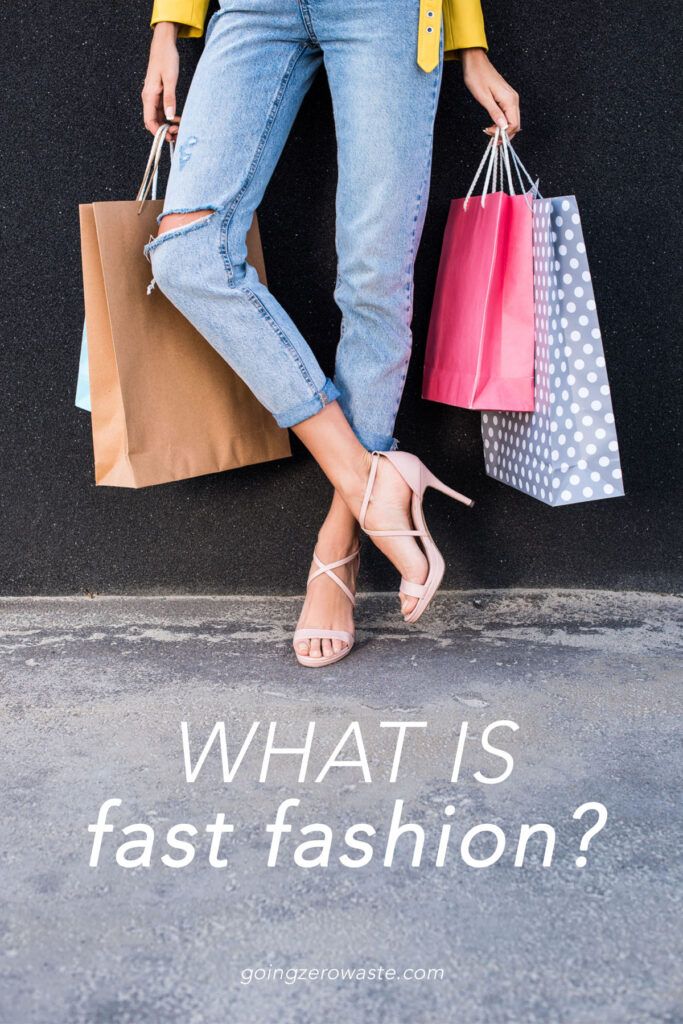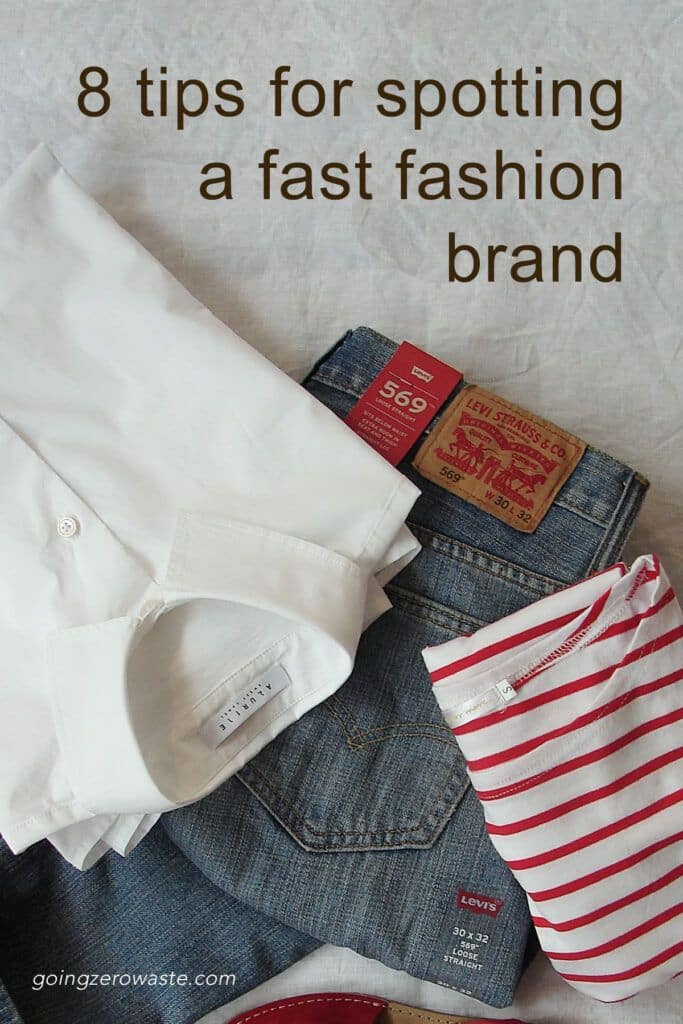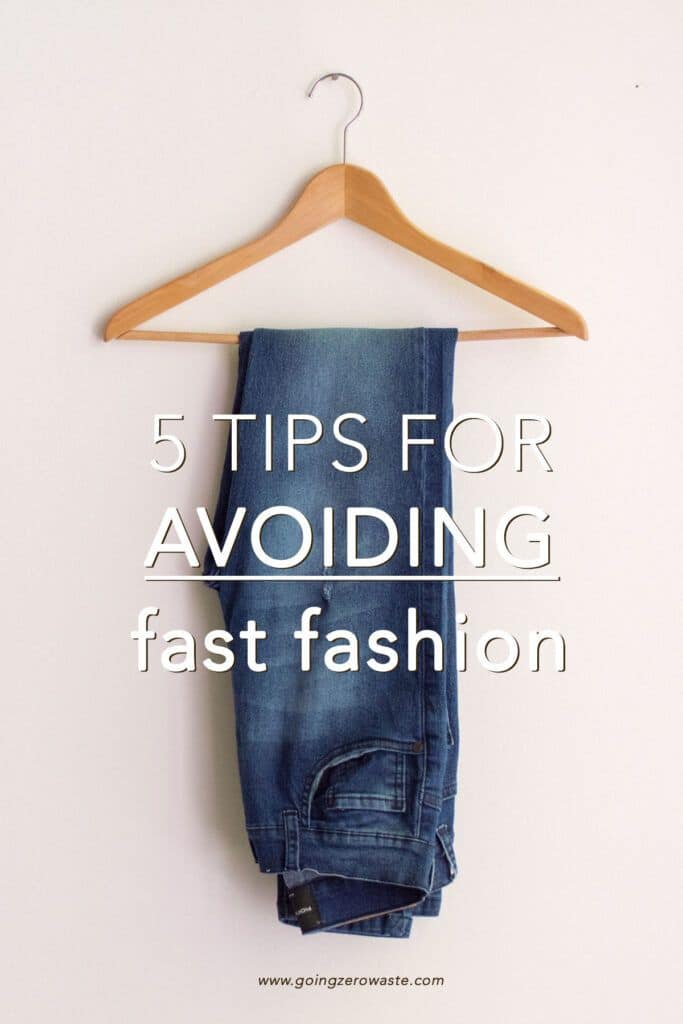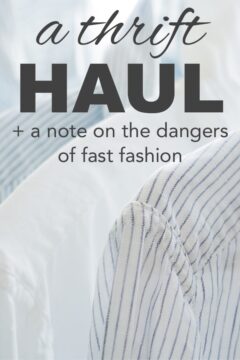Last Updated on February 1, 2023
What is fast fashion, and why should you avoid it? Buying clothes should not wreak havoc on our environment.
We are going to answer several of those questions about fast fashion brands to avoid and solutions to fast fashion! Everything from poor working conditions and harmful processes at fast fashion companies can be found.

Table of Contents
fast fashion companies
Fast. Faster. Fastest. I’m sure you’ve heard of fast food, but what is fast fashion?
If you’ve been in the eco space for a while, then you’ve probably heard the term A LOT. If you’re new to the eco space, well, welcome! Check out my blog posts for beginners, which are full of ways you can have a more positive impact on the planet.
The term ‘fast fashion’ has become quite the buzzword these last few years, so in this post, I’m going to be taking a look at the history of the term, where it came from, what it means, how you can avoid it, and give you some solutions to fast fashion.
what is fast fashion?
Fast fashion companies make an abundance of inexpensive clothing produced quickly by large retailers to keep up with ever-changing trends.
But don’t take my word for it. Here’s a definition from a few different sources.
Inexpensive clothing produced rapidly by mass-market retailers in response to the latest trends.
DICTIONARY
The globalised market for fashion manufacturing has facilitated a “fast fashion” phenomenon; cheap clothing, with quick turnover that encourages repurchasing.
FASHION REVOLUTION
Fast fashion is a contemporary term used by fashion retailers for designs that flow from the catwalk quickly to capture current fashion trends.
WIKIPEDIA
Clearly, it all boils down to quick, cheap, and trendy clothing. Now, all of that sounds great, so what’s the problem?
why is fast fashion so cheap?
Have you ever wondered why buying clothes at any of the fast fashion companies is so cheap?
Take a moment to think about a $5 t-shirt. Could the raw materials have been grown sustainably? Could the person who sewed it have been paid a living wage? When we look through the supply chain of fast fashion companies, enormous problems begin to emerge.
Fast fashion is cheap because brands are exploiting people and the planet!
RELATED: 5 Tips for Defining Your Personal Style and Creating an Ethical Wardrobe
what is the problem with fast fashion?
There are a few problems with fast fashion. I’ve broken them down into two subheadings which I think encompass the majority of the issues: the environmental impact and the human rights issues.
I think this quote from fashion journalist Lucy Siegle says it best, “Fast Fashion isn’t free. Someone somewhere is paying for it.”
If you’re looking for a great documentary that covers many of these topics, I highly recommend the True Cost.
the environmental impact:
The fast fashion industry isn’t regulated very well. The goal is to create products as quickly and cheaply as possible, so a lot of corners are cut — especially when it comes to the environment.
greenhouse gas emissions:
The fast fashion market is responsible for more greenhouse gas emissions than international shipping and aviation combined. (source)
textiles:
Polyester is the most popular fabric used by fashion retailers. Polyester is plastic, and when you wash your polyester garments, they shed microplastic pieces into our waterways that are so tiny they can’t be filtered out.
ORB media found plastic in 84% of drinking water worldwide. We are quite literally drinking yoga pants. For more information on this, see my blog post Microplastics: What Are They?
As for cotton, most fast fashion brands source this raw material from India. It is one of the most pesticide-heavy crops in the world.
The dirt has become so full of pesticides and chemicals that it’s becoming increasingly difficult to grow crops, but the problems don’t end there.
These pesticides wind up in the water table, which has huge effects on human health. Of all the babies born there, up to 80% have severe physical and mental disabilities.
dyes:
The fashion industry uses a lot of synthetic dyes like disperse, reactive, acid, and azo dyes to create rich hues on garments. It takes 200 tons of water to create one ton of fabric, and most of that water is returned to nature as toxic waste.
Disposing of wastewater is unregulated, so big brands and factory owners aren’t accountable for the harm this causes local communities and the environment.
If you’re interested in learning more, you should watch the documentary River Blue, which tracks some of the most polluted rivers associated with the fashion industry.
landfills and waste:
The EPA estimates that textile waste occupies nearly 5% of all landfill space, and that the average US citizen throws away 70 pounds of clothing and other textiles annually.
incineration:
Most brands incinerate their clothing and products because selling them at a deep discount would hurt their ‘image’. And this isn’t just fast fashion brands – I’m talking luxury brands too.
Here are some of the luxury and fast fashion brands to avoid:
Cartier destroyed about $563 million worth of watches over the course of two years. Burberry incinerated $36.8 million worth of merchandise. This practice also happens at Urban Outfitters, Walmart, Eddie Bauer, Michael Kors, Victoria’s Secret, J.C. Penny, and more.
the human rights issues:
Even more important than the environmental impact of fast fashion companies are all of the human rights issues. I used to think that garments were sewn by industrial machines, but they’re not!
They are sewn by living, breathing human beings, and a lot of them are treated very poorly.
child labor:
Child labor can be found at all levels of the fashion industry. Children are often used in cotton fields to cross-pollinate plants, they also work in spinning, weaving, and dyeing mills.
Sequins and other bedazzled aspects on cheap clothing often indicate child labor, according to Lucy Siegle.
Children as young as eight work in the tanneries of Bangladesh, which produce leather goods. Many of these children are exposed to toxic chemicals that have a direct impact on their lifespan.
poor working conditions:
Many of the factories that mass produce clothing are unsafe structurally, electrically, and more. Accidents, fires, injuries, and diseases are all common occurrences.
Most buildings have little to no ventilation, so workers wind up breathing in fibers and toxic substances.
Because clothing orders are turned so quickly, garment workers are regularly denied breaks to go to the bathroom or even drink water. They also regularly face verbal and physical abuse.
underpaid labor:
Garment workers are often forced to work 6-7 days a week for 14-16 hours a day. During peak seasons, they can be forced to work until 2 or 3 am to meet a deadline.
Children and adult employees earn as little as £6.50 a month which is significantly less than the £41.80 minimum wage for entry level garment workers set by the government.
when did this all start?
A brief history of the fashion industry:
BEFORE THE INDUSTRIAL REVOLUTION: A lot of clothing was made custom or at home.
INDUSTRIAL REVOLUTION: Ready-to-wear clothing was sold in stores.
MID 20th CENTURY: Fashion designers created clothing for four seasons: winter, spring, summer, and fall.
INTO THE 21st CENTURY: Someone got a big bright idea that creating more seasons = more opportunity to sell trendy clothes. Retailers now have 52 micro-seasons. Basically a season each week.
The goal of fast fashion is to make you feel like you’re out of style the moment you wear something – basically single-use clothing.
RELATED: 5 Tips for Finding Quality Clothing

how to spot a fast fashion brand?
If you head to the mall, you’re probably going to see A LOT of fast fashion brands. There are so many fast fashion companies to avoid! Think Forever 21, Zara, Uniqlo, Old Navy, GAP, Topshop, Primark, Victoria’s Secret, Guess, Fashion Nova, Boohoo, Pretty Little Thing, Mango, Nasty Gal, etc., etc.
But, instead of just listing a bunch of brands, I want to share with you a few ways you can identify whether or not a brand sells fast fashion.
- Where are their garments made?
- Do they have transparent supply chains? (Take a look at their website! If they proudly tell you where their factories are, that’s a good sign. If you have to dig for it through their FAQ page – not a good sign.)
- What are the materials they’re using? Are they using recycled, renewable, and natural-based materials? Are they using cheap fabrics?
- How well are the garments made? Are they made to last?
- Is the brand selling THOUSANDS of styles?
- Are new styles coming in every week?
- Is the clothing extremely trendy and will it be out of style next year?
- Did you see a trend from fashion week quickly in a store window?
Be sure to check out my blog post What Is Greenwashing? if you want to know how to better identify when a brand is or isn’t doing good work!
RELATED: 5 Tips for Maintaining and
Taking Care of Your Clothes

solutions to fast fashion
If you just read this blog post and are concerned about what you can do… don’t worry! There’s a lot you can do.
- Take care of the clothes that you already own!
- Buying clothes secondhand and choosing used clothing when you want something trendy and fun.
- Borrow clothes from friends and family members.
- Rent clothing for special events.
- Invest in timeless, sustainable fashion pieces that are made ethically and will last a long time.
RELATED: 10 Places to Shop Secondhand Online
the rise of slow fashion
One of the things that really excites me is the rise of slow fashion.
After fast food became popular, there was a resurgence of ‘slow-food’ or farm-to-table dining.
Similarly, we’re seeing a resurgence in slow fashion. Slow fashion isn’t about chasing a trend, it’s timeless fashion that will look good today, tomorrow, and 10 years from now.
I know that buying slow and sustainable fashion can be really expensive and often unaffordable for a lot of people.
If you can’t buy from sustainable fashion brands, try to look for pieces that are well made, wash them less, and repair them.
frequently asked questions
how can I avoid fast fashion companies when I don’t have much money?
While it’s tempting to head to Old Navy and buy a $5 t-shirt, you would be better off buying secondhand instead. Go to yard sales or thrift stores. Or do a clothing swap with friends. Not having a lot of money isn’t a good excuse to be buying clothes from fast fashion stores.
how do I look good while wearing sustainable clothing?
I get that you want to look and feel good. I recommend finding pieces that you can wear in a variety of ways so you can get a lot of usage out of them. Choose things that will look good no matter what the styles are at the moment. You can dress up outfits with jackets, jewelry, or shoes. Also, don’t underestimate the power of great hair and makeup!











Thanks a lot for sharing about fast fashion. I really enjoyed reading this beautiful post. Keep sharing an informative post. https://hancockssignetrings.com/